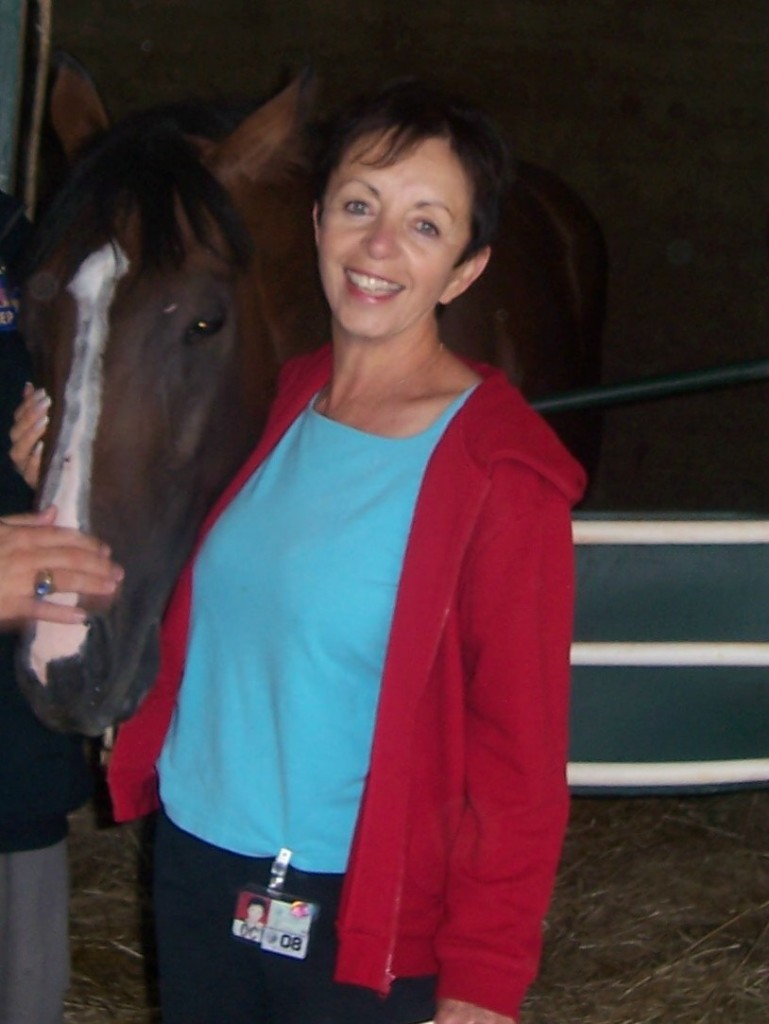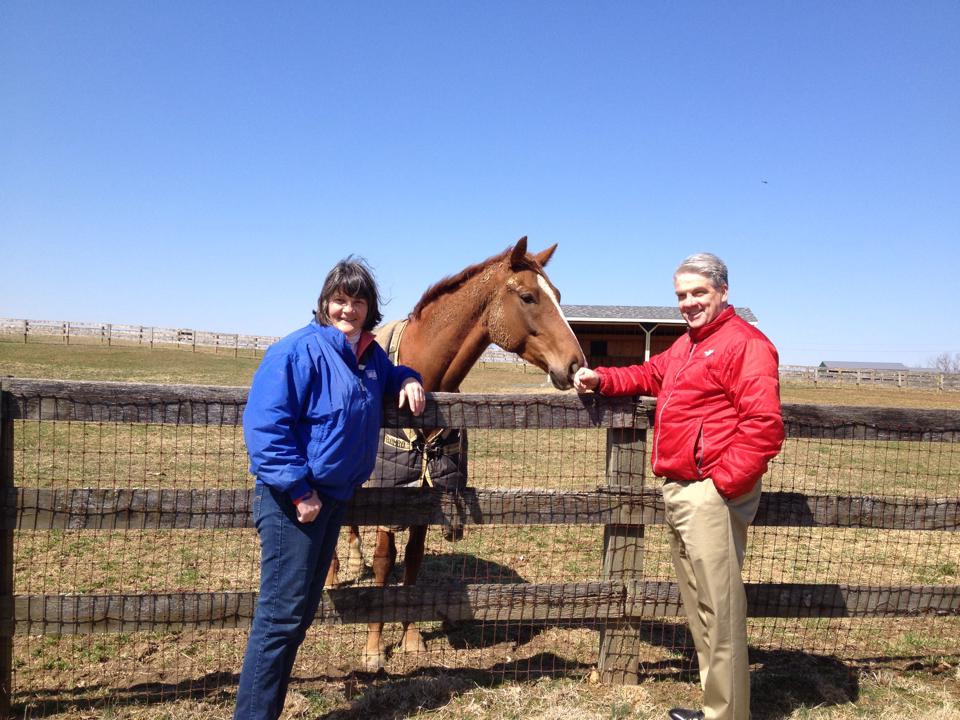
Madeline Auerbach chairs the California Management Retirement Account (CARMA) and is vice chair of the Thoroughbred Aftercare Alliance. Here she poses with Thoroughbred Shem Tov.
On track to provide $2 million in grants to Thoroughbred charities across America, doubling its initial contribution since beginning a landmark effort to provide a safety net to charities rehabilitating and re-homing ex-racehorses, the Thoroughbred Aftercare Alliance is on a grand mission that began, in part, with an innocent question.
Madeline Auerbach, a well-known California racehorse owner simply wanted to know how to find a really good retirement home for her ex-racehorse Lenny From Malibu. “I was really unaware of the whole panoply of retirement, and I started to get my feet wet, and looking for a good home for him. I knew little about how to retire him, and I wanted to make sure I knew where he was at all times,” she recalls.
Beginning in the mid-2000s, the petite horseman, admittedly a little naïve when she started, set forth on an odyssey to create a mechanism by which the Thoroughbred industry—owners, breeders, anyone whose livelihood is affected by a Thoroughbred—could donate to Thoroughbred aftercare within a construct that would adhere to the highest standards of fiduciary accountability and trust.
She explains, “I realized soon after we started taking in money (to distribute to horse charities) that we better make sure we do a damn good job with how we distribute it … and we needed to be certain we knew where the money was going, we needed proof it was going to the horses.”
In this week’s Clubhouse Q&A, Auerbach discusses her roles as the chair of the California Retirement Management Account (CARMA), which informed the creation of the Thoroughbred Aftercare Alliance (TAA), on which she currently serves as vice chair.
Q: Your deep involvement with two funding charities that help Thoroughbred ex-racehorses started with your own horse.

New Vocations Racehorse Adoption, one of the accredited 26 charities, receives a visit from a reporter.
I was very naïve when I started to look for a good home for Lenny from Malibu. At the time, I thought he should go live in a pasture and run around. I’ve since had a metamorphosis in my opinion of that (vision of retirement), and grown beyond it.
But it was around this same time, around 2006, that I joined the Thoroughbred Owners of California and I realized that we didn’t have a Code of Ethics. So I volunteered to write one and this is the point that I started to get really involved in how and where horses went after racing.
Q: After you wrote a check to sponsor your own retiree, Lenny from Malibu, for a life at a retirement farm, the larger issue of retirement funding came front and center.
As I worked with Tranquility Farms, and began to understand how much money is needed to sponsor a horse, I learned how big that commitment really is. And it occurred to me that with all the horses in need of retirement, it’s a daunting number. And I also realized there was no funding mechanism, nothing that really addressed how to care for horses who didn’t go to the breeding shed after they retired.
Q: The California Retirement Management Account (CARMA) started to roll around the time that Eight Belles perished in the 2008 Kentucky Derby.
With Eight Belles there was a lot of negativity and there was nobody around who had really good answers when it came to talking about retirement. At least, not in California. There was no central spokesperson. Around this time, we started speaking to the California Horse Racing Board about funding CARMA to help transition horses off the track.
They were very open to this, and agreed to contribute 3/10ths of 1 percent from purse money to our effort. It was a very small percentage, but we took in about half a million a year. So before we distributed the funds, we spent weeks, months and years developing the standard protocol governing who would be eligible for these funds.

A YMCA camp visits Old Friends in Kentucky, a Thoroughbred charity begun by Michael Blowen, and accredited by the TAA.
Q: It was essential to CARMA’s good name that recipients be accountable for their funds.
We developed a protocol that charities had to be certified 501 c 3, in good standing with the community, pay their taxes, and be legitimate charities. And anybody who got money from us had to understand that (the funds) entitled us to make site visits to ensure the money was going to the horses. We wanted proof that it was going where it should.
Q: CARMA’s good reputation attracted more goodwill, and greater donations.
We were approached by the Stronach Group, which agreed to match our (purse) donations. So CARMA got rolling, and Santa Anita gave us an office.
Q: Working with aftercare partners, horses are “triaged” at Winners’ Circle Ranch, assessed, and eventually placed with an appropriate organization for re-training.
We’ve placed approximately 25 to 30 horses a year this way. We take the horses off the track and follow up with them at Winners’ Circle Farm … where a lot of vet tech training is taking place, so the work they’re doing for horses is also a teaching tool. The placement program is still relatively young, but we’re trying to expand to Northern California to do something similar.
Q: How did CARMA inform the creation of the Thoroughbred Aftercare Alliance?
A few years ago, I got a call from (prominent horse owner) Jack Wolf, who said this was an idea whose time had come.
There had been many attempts in this industry to raise money for retired racehorses, and most haven’t ended well. In part, it’s because the industry is so fragmented. We don’t have central control; we don’t have anything that binds us together. Racing and medication rules, for example, are different from state to state, and we have no central funding for a program like this.
Q: The TAA got a head start by following CARMA in its creation of codes of standards, methods for collecting and distributing funds.
Because we have such a fiduciary responsibility to our donors, we needed to make sure we knew where money went. The charities we support have to be accredited, and it’s not easy to become accredited with the TAA. We currently have 23 charities, and we hope to accredit another 26 more in the next round.
When we accredit somebody, they agree to host site visits by our vets, and by our inspectors. And an accreditation (status) stands for two years; it requires a charity re-apply. This means you can’t get your accreditation and forget about it.
Q: Your methods have won huge support in the industry.
The Jockey Club is now assessing a $25 registration fee, which goes to the TAA and breeding farms pay a percentage of one stud fee. The secret formula for both CARMA and the TAA is that the fee is so small, so people don’t feel like they’re paying more than their fair share.
We identified those who should support (retired racehorses): owners, trainers, breeding farms, media, truckers, suppliers, and veterinarians. And we assigned a small percentage— 3 tenths of 1 percent. But, it adds up.
Last year the TAA gave out $1 million in grants, and this year we’re on track to give out $2 million. ♦
![]() If you enjoy stories like these, please consider visiting the blog’s new store, Off-Track Products. Proceeds will help sustain this blog in the future, and go to charity.
If you enjoy stories like these, please consider visiting the blog’s new store, Off-Track Products. Proceeds will help sustain this blog in the future, and go to charity.



Great progress. However, the wagering companies such as TVG, XPRESS BET, BET AMERICA etc. Should contribute 1% of wagering solely for OTTB groups. These companies make BILLIONS off the racehorse and contribute little or nothing to their aftercare. The 1% contribution should be mandatory.
Very proud to call Madeline a Mentor and Friend. Using your life to give back– there is no higher calling. Thank you for writing this piece.
What a fantastic idea…started with that question. I too have raced and wondered afterwards…where do they go? I was told by the “managing owner”…oh, we found him a nice home in “wherever”. But never more information than that.
I think the clincher to all your work is….accountability. No money falls through a crack.
And the tiny fees times hundreds of thousands of assessments is brilliant. That way everyone can help and it doesn’t break anyone’s pocketbook!
This is epic! I’m so happy to hear that these smart groups are forming and are being monitored so they can bring some success to the very big problem of retired or unwanted tbs…